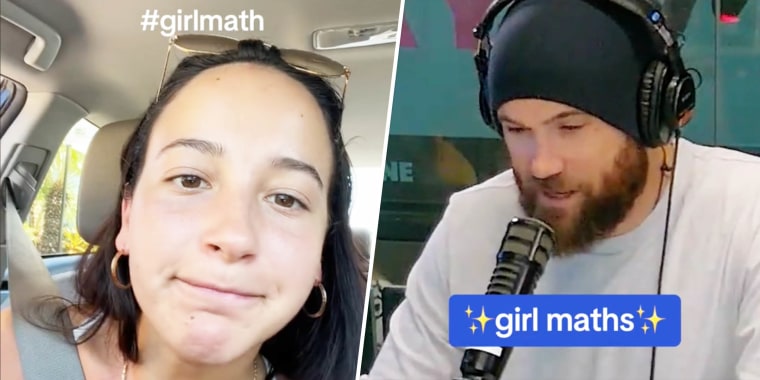Move over, girl dinner — it's time for girl math.
The latest discourse to hit the social media platform revolves around spending, consumerism and and economics, both real and imagined. In videos, young women describe the logical maneuvers that allow them to justify spending money on luxuries ranging from Botox to Taylor Swift's Eras Tour tickets.
Read on to see some examples of what exactly girl math looks like and how personal finance experts are reacting to the trend.
What is 'girl math'?
In the world of "girl math," cash is not real money, buying on sale is a form of saving and cosmetic procedure is an "investment in your future self."
"If I pay for something in cash, it feels like I got it for free," one TikToker explains. Another example she shares? If she cancels a manicure appointment, she now has that money to spend.
The TikToker behind the @mixedupmoney personal finance account posted a list of her own girl math equations:: "If the Starbucks app is laded, the coffee is free. If my favorite store is having a sale, I have to buy something, otherwise I'm losing money. Cash is not real money; if I buy something with cash, it is free." And, if you use a $300 purse every day, it is "basically free."
Everyone has their own version of girl math, as comments and videos lay out. Not spending money on something translates to extra spending money. Making returns is making money. And "anything under $5 is basically free," TikToker @samjamesssss said.
TikToker @_arianarosado described a girl math problem in action: She bought a Lululemon shirt for $68, exchanged it in the store for $58, and received $10 back on her credit card.
“So I go to Lululemon, I don’t spend money, I get money,” she said. “So I got ten dollars. And I was like, well now ... I get to go get food with the money that I just made.”
Where did 'girl math' begin?
Commenters on on videos point out this is relatable for many: "I'm so glad it's not just me," someone wrote here. Another: "This should be taught in economics 101."
But where did it all start?
The girl math trend appears to have started with a recurring radio segment by the same name, hosted on the morning show "Fletch, Vaughan & Hayley" by the New Zealand-based radio station ZM.
In the segment, listeners send in details about purchases they have made and their costs, while show co-host Hayley Sproull and other producers on the team work together to justify the spending until it is "basically free."
In one segment, Hayley and the team attempt to justify a viewer's purchase of $5,600 worth of accommodations, flights and concert tickets for all four nights of Taylor Swift's Eras Tour performances in Sydney, Australia.
"You would have had to pay that much for flights for one night or four nights," one of the producers reasoned.
"How much is one set of flights to Australia? We worked it out at about $600," Sproull said. "So she's saved $1,800 ... we're going $5,000 dollars minus $1,800 cause she doesn't have to buy eight flights. Now we're only justifying $3,200."
The team gradually works the price tag down until they reach the "free" mark, provided the viewer sublets her apartment for the days she's gone and re-watches the concert videos on her phone a thousand times.
What do personal finance experts think?
Lindsey Stanberry, former executive editor at Fortune and author of The Purse newsletter, tells TODAY.com that she enjoys the relatability and humor of the girl math trend.
However, she also feels "weird" about the portrayal of young women as people who "don't really know how to handle money."
"While I think that the trends definitely started as good fun ... the women who started it are hilarious and it's very funny and very tongue in cheek and that's great — it can quickly spiral into being taken as a representation that women don't know how to manage their money, and I don't think that's true," Stanberry says.
Stanberry adds that she indulges in some elements of girl math too: Coffee bought with a loaded Starbucks card is free, insurance reimbursements for medical expenses is "found money," and cash back on credit cards is also "found money."
Ultimately, she says although she feels that the trends "dumbs down" young women's spending habits, she appreciates seeing "women feeling comfortable talking about their finances" through the trend.
"You could argue that it's not bad math. They're being thoughtful about how they're spending their money," Stanberry says.
